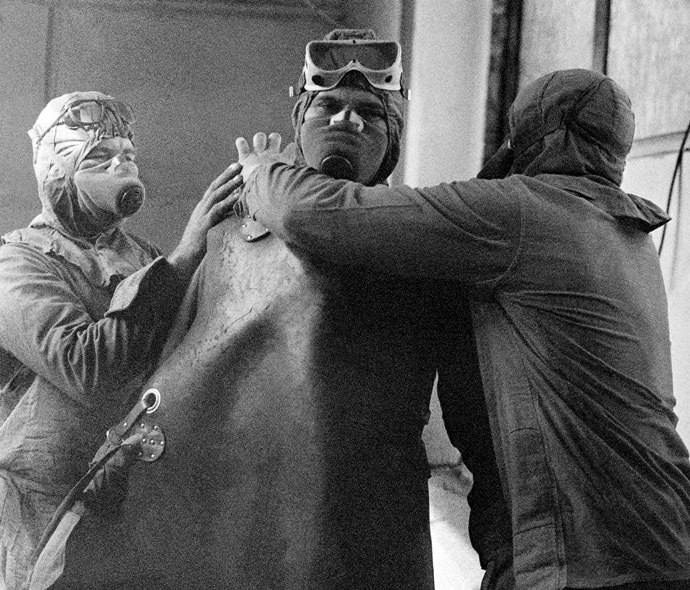Chernobyl then and now: 28 haunting images from nuclear disaster An accident happened at the Chernobyl Nuclear Power Station on April 26, 1986. April 26 is the day the world commemorates the worst-ever nuclear disaster. Twenty-eight years after the Chernobyl power plant blew up, RT remembers the tragedy and takes a look at the changes that time has wrought to the fallout zone. Chernobyl was the first nuclear power plant in Soviet Ukraine, a flagship of the peaceful atomic energy program of the USSR.  The first nuclear power plant in Ukraine Just 3 kilometers from the plant, the city of Pripyat was built. Its purpose was to house nuclear experts and workers servicing the plant, as well as security troops.  New shift starting work at the Chernobyl nuclear power plant A residence for highly skilled and educated Soviet citizens, it was meant at the time to be a model Soviet city, with forward-thinking town planning and modern architecture.  Housing estate in town of Pripyat, Kiev Region. But early in the morning of April 26, 1986, the nuclear industry's flagship met its iceberg. But unlike the Titanic, Chernobyl's disaster was due to human error, first and foremost.  The control room of the Chernobyl nuclear power plant at Pripyat. It overheated and built up pressure, until its structure failed and it blew up.  View of the Chernobyl nuclear power plant's fourth reactor in this May 1986 file photo. It took the Soviet authorities a whole day to comprehend the scale of the disaster, and to order the full evacuation of Pripyat.  Decontamination of the Chernobyl nuclear power plant buildings. In three hours some 50,000 people left the city, not knowing that they would never return.
In the following seven months massive effort was made to decontaminate affected areas...  Military hardware working in the Chernobyl disaster area undergoes decontamination at the special point. ...and erect a metal and concrete shelter over Reactor 4.  The building of the sarcophagus around the fourth reactor of the Chernobyl nuclear power plant after its explosion is seen in this 1986 file photo.  Liquidator team ready to climb the Chernobyl nuclear reactor top after the disaster. Ukraine, Russia and Belarus sustained the most damage, although increased radiation was detected far across Europe.  While Reactor No. 4 was damaged beyond repair, other parts of the power station remained functional. Shut down in the wake of the blast, Reactors 1, 2 and 3 were restarted between October 1986 and December 1987. Chernobyl continued producing nuclear power until December 2000.  A worker at the Chernobyl nuclear power plant checks the radiation level in the engine room of the first and second power units in this June 5, 1986 file photo. Fallout from Chernobyl continues to wreak havoc to human health, almost three decades on from the disaster.  Olga Derzhutskaya, 6, undergoes medical observation after an operation for thyroid cancer at the ra diation medicine center in Gomel, April 9, 1996 Emergency workers who tackled the disaster died and suffered massive damage to their health.  A worker of the Chernobyl nuclear power plant gives way to emotion during commemorations at the station marking the 10th anniversary of the explosion in the station's fourth reactor in Chernobyl April 26, 1996 There are also more cancer risks and a huge expulsion zone in the middle of Europe.  A father feeds his child in the Belarus capital of Minsk special hospital, which deals with radiation related illnesses April 23, 1996. A small amount of radiation escaped at the Chernobyl nuclear power station on the eve of the 10th anniversary of the world's worst nuclear disaster it was reported April 25, 1996 Pripyat and a handful of old villages near Chernobyl plant are ghosts, although a few evacuated residents decided to return in defiance of the danger still posed by radiation.  While living in the exclusion zone is not the best idea, radiation levels have dropped low enough for short visits to be safe. Chernobyl is an interesting destination for scientists and adventurous tourists now.  A man looks at the New Safe Confinement (NSC) structure at the Chernobyl Nuclear Power Plant April 23, 2013. The project was expected to be completed by October 2015 costing some 1.54 billion euro. But now Ukraine is in disarray and is consumed with contemporary conflicts rather than radioactive legacies of Chernobyl.  The first half of the Chernobyl New Safe Confinement, or NSC, an arch that which will cover the reactor building, is seen after it was pushed to its site at the Chernobyl Nuclear Power plant on April 3, 2014. |
alphawolf posted on 24-9-2014 03:12 PM
Tu dia buat containment unit baru tu.
Tapi positifnya dari tagedi ni, kawasan sekitar dah jadi ka ...
alphawolf posted on 25-9-2014 08:02 AM
Beruang, serigala, babi hutan, rusa, burung liar....tapi ada yg alami mutasi.

ADVERTISEMENT